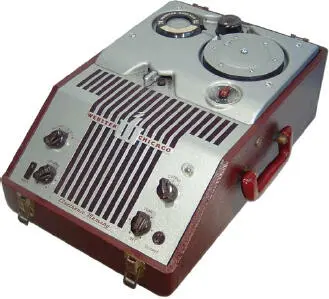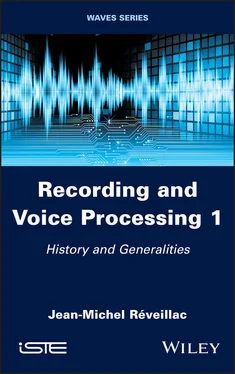– audio processing plugins;
– tube and JFET mic amplifiers;
– microphone pairs.
Volume 2 presents a preface and an introduction identical to those of Volume 1 followed by four chapters, a conclusion and five appendices:
– processing hardware and software;
– configuration and audio channel;
– voice recording;
– special effects.
Appendices 1–4 are taken from Volume 1 to complement the previous chapters by including:
– sound unit;
– audio connectivity;
– audio processing plugins;
– microphone pairs.
Appendix 5of Volume 2 provides details on the types of software plugins available from different vendors and operating systems.
The conclusion sheds light on the whole book and gives a brief overview of the future evolution of voice recording.
Each volume can be read separately. While there are concepts that are dependent on another chapter, references to the relevant sections are given. However, the first two chapters of Volume 1, devoted to the history of recording and to the human voice, provide a contextual basis for the understanding of several notions that you will find in the following chapters.
If you’re a novice on the subject, I strongly advise you to read them first, to discover the basics of the subject of this book.
For the others, I hope that you will discover new notions that will enrich your knowledge.
At the end of each volume, you will find a reference list and a list of Internet links.
A glossary is also present; it will explain some acronyms and terminologies very specific to sound recording, recording and mixing.
This book uses the following typographical conventions:
Italics , which are reserved for important terms used for the first time in the text which may be present in the glossary at the end of the book, mathematical terms, comments, equations, expressions or variables.
Remarks are indicated by the presence of the keyword: NOTE. They complete the explanations already provided.
The figures and tables all have a legend that is often useful for understanding.
Vocabulary and definition
As with all techniques, voice recording has its own vocabulary. Certain words, acronyms, abbreviations, initialisms and proper names are not always familiar and will be included in the glossary.
I would especially like to thank the ISTE Ltd team and my editor Chantal Ménascé, who trusted me.
Finally, I would like to thank my wife, Vanna, and my daughters Océane and Léa who supported me throughout the writing of this book.
August 2021
Since Plato and Aristotle, we have often heard this quote, “ The voice is the mirror of the soul ”. It is true that before understanding the meaning of a word, we must understand its emotional side; we recognize the intonation that makes a voice more or less unique. The paralinguistic characteristics of a voice, that personalize it, take priority over the meaning of the message that is delivered. They express the emotional aspect of the interlocutor and favor the transmission of emotions.
It is also necessary to take the environment into consideration; the voice exists only through its medium, the air which surrounds us. The numerous acoustic variables, vocal cords and different morpho-anatomical cavities of the individual form the timbre of the voice, which can be modified during its diffusion by the environmental medium in which it is established.
Each individual has a different timbre that represents a sound signature. The voice is the reflection of the body and the spirit, but let us not assume that its characteristics are as static and reliable as the genetic code or fingerprints. They are variable, determined by numerous parameters linked to morphology, imagination, environment, affect and even gestures, even if many of these elements do not affect the hard core that builds the essence of a voice.
The recorded voice brings different sensations that often flout the canons of the direct voice, spoken or sung, but it is far from being unpleasant and it has become, by force of things, a standard. Our world is constantly saturated with music or recorded voices; few people can claim to have heard a particular performer with his or her live voice. Voices are optimized for recording and broadcasting; they must remain intelligible and are sometimes enriched, or even placed in a virtual environment, but our ears have become accustomed.

Figure I.1. Vocal differences in the same sentence. 3D spectrogram of a male voice, on the left, and a female voice, on the right
(source: www.projectrhea.org). For a color version of this figure, see www.iste.co.uk/reveillac/recording.zip
It is in part the facts I have just mentioned that led me to write this book, to which I would add the pleasure of bringing, to one or more performers, the possibility of discovering and hearing themselves on a medium such as a CD, DVD, streaming platform, podcast, etc.
I will not forget the listeners nor the public for whom we all work in fine : artists, commentators, singers, sound engineers, technicians, etc.
This work, as its title suggests, is above all devoted to the recording and processing of the voice. I have tried to aggregate a set of elements that contribute and intertwine in this same field, taking care of the ins and outs.
I remain convinced that in order to understand the techniques and handle certain hardware or software, it is useful to know what surrounds them. Throughout the book, I have often specified the historical context without forgetting the personages to whom we owe these wonderful inventions. They made it possible for us to listen to the voice, whether spoken, whispered, sung or shouted. At the beginning of the 21st century, and for more than 120 years already, this seems so common, so futile, so banal, but what would our ancestors from the past centuries think of it?
Volume 1 of this book, more oriented towards theory and generalities, will begin with a short history of the recording of the spoken and sung voice from the first machines until today, which will be followed by an outline of the mechanisms and specificities that characterize the human voice.
With these elements, we will approach microphones, an essential and necessary tool for voice capture, to then understand the recording environment, whose influence creates the conditions for a good recording.

Figure I.2. A wire recorder, the Webster Chicago 180-1 (1949). For a color version of this figure, see www.iste.co.uk/reveillac/recording.zip

Figure I.3. The famous Neumann U67 tube microphone and its power supply. For a color version of this figure, see www.iste.co.uk/reveillac/recording.zip
Volume 2, oriented towards studio work, will describe the hardware and software tools that are useful for efficient processing during recording and will include them in the audio chain that will support them. Different examples of configurations will be presented, from the most modest to the most advanced.
Читать дальше















